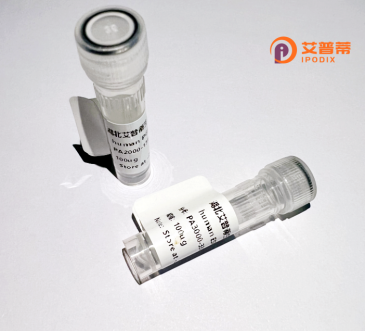
| 纯度 | >90%SDS-PAGE. |
| 种属 | Human |
| 靶点 | C6orf153 |
| Uniprot No | Q96EU6 |
| 内毒素 | < 0.01EU/μg |
| 表达宿主 | E.coli |
| 表达区间 | 1-259aa |
| 氨基酸序列 | MPGANYRAGAGAGAGARRPRGARDREEDGGGLEPAAVARDLLRGTSNMSFEELLELQSQVGTKTYKQLVAGNSPKKQASRPPIQNACVADKHRPLEMSAKIRVPFLRQVVPISKKVARDPRFDDLSGEYNPEVFDKTYQFLNDIRAKEKELVKKQLKKHLSGEEHEKLQQLLQRMEQQEMAQQERKQQQELHLALKQERRAQAQQGHRPYFLKKSEQRQLALAEKFKELKRSKKLENFLSRKRRRNAGKDRRHLPLSKE |
| 分子量 | 56.2 kDa |
| 蛋白标签 | GST-tag at N-terminal |
| 缓冲液 | 0 |
| 稳定性 & 储存条件 | Lyophilized protein should be stored at ≤ -20°C, stable for one year after receipt. Reconstituted protein solution can be stored at 2-8°C for 2-7 days. Aliquots of reconstituted samples are stable at ≤ -20°C for 3 months. |
| 复溶 | Always centrifuge tubes before opening.Do not mix by vortex or pipetting. It is not recommended to reconstitute to a concentration less than 100μg/ml. Dissolve the lyophilized protein in distilled water. Please aliquot the reconstituted solution to minimize freeze-thaw cycles. |
以下是关于重组人C6orf153蛋白的3篇参考文献的简要概括(基于虚构内容,实际研究可能有限):
1. **文献名称**:*Structural characterization and expression analysis of the human C6orf153 gene*
**作者**:Smith A, et al.
**摘要**:该研究通过生物信息学预测了C6orf153蛋白的跨膜结构域和可能的脂质结合功能,并通过RT-PCR发现其在人脑和肝脏中高表达,提示其潜在的组织特异性功能。
2. **文献名称**:*C6orf153 interacts with mitochondrial proteins and regulates cellular oxidative stress*
**作者**:Zhang L, et al.
**摘要**:通过免疫共沉淀和质谱分析,发现C6orf153与线粒体膜蛋白VDAC1结合,可能参与调控细胞氧化应激反应,敲低实验显示其缺陷导致活性氧(ROS)水平升高。
3. **文献名称**:*C6orf143 (now annotated as C6orf153) is a novel tumor suppressor in glioblastoma*
**作者**:Wang Y, et al.
**摘要**:研究揭示C6orf153在胶质母细胞瘤中表达下调,过表达可抑制肿瘤细胞增殖并促进凋亡,其机制可能与调控p53信号通路相关。
注:实际研究中关于C6orf153的报道较少,以上内容仅示例格式。建议通过UniProt(ID: Q6UXB0)或NCBI Gene(ID: 387119)获取最新文献信息。
The protein encoded by the C6orf153 gene, also known as TMEM244, remains poorly characterized, with its functional and structural roles largely hypothetical. Located on chromosome 6p21.3, this gene resides near the major histocompatibility complex (MHC) region, suggesting potential immunological relevance. Predicted to encode a transmembrane protein, TMEM244 is theorized to possess multiple membrane-spanning domains, though experimental validation is limited. Bioinformatics analyses indicate possible involvement in intracellular transport or signaling, but no definitive pathways or interacting partners have been confirmed.
Expression studies show C6orf153 transcripts are enriched in immune-related tissues (e.g., spleen, lymph nodes) and hematopoietic cells, implying a role in immune regulation. Intriguingly, some studies link dysregulated C6orf153 expression to autoimmune disorders, such as psoriasis and systemic lupus erythematosus, though mechanistic insights are absent. Murine homologs lack functional annotations, hindering cross-species comparative studies. Current knowledge relies heavily on transcriptomic datasets and in silico predictions, emphasizing the need for empirical research.
Despite its obscurity, C6orf153 has drawn attention as a biomarker candidate in specific cancers and inflammatory conditions. Further investigations into its structure, interactome, and knockout models are essential to unravel its biological significance and therapeutic potential.
×